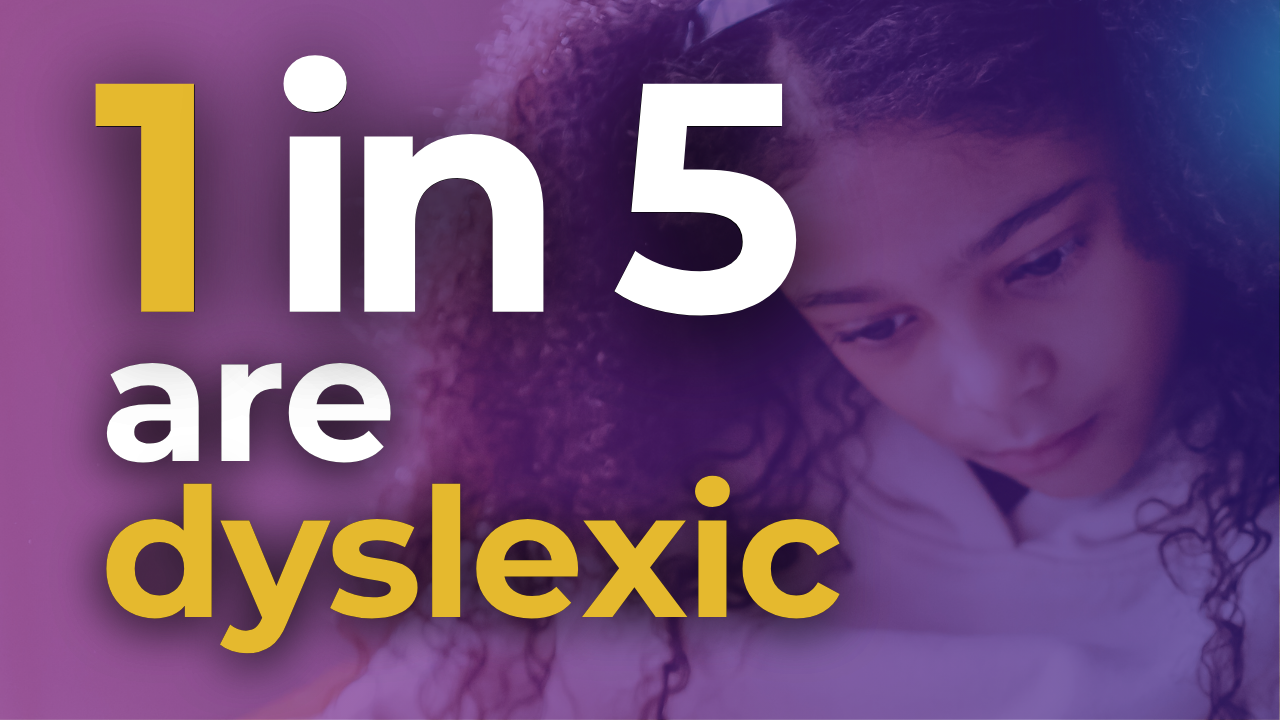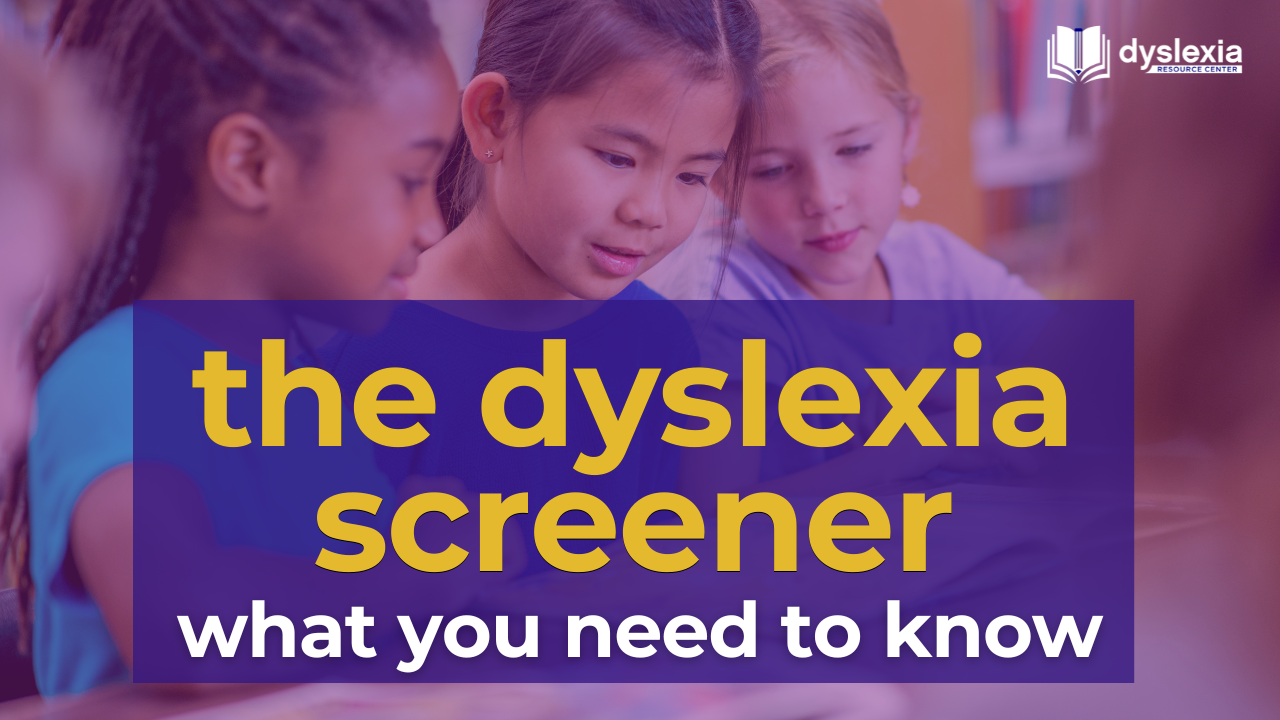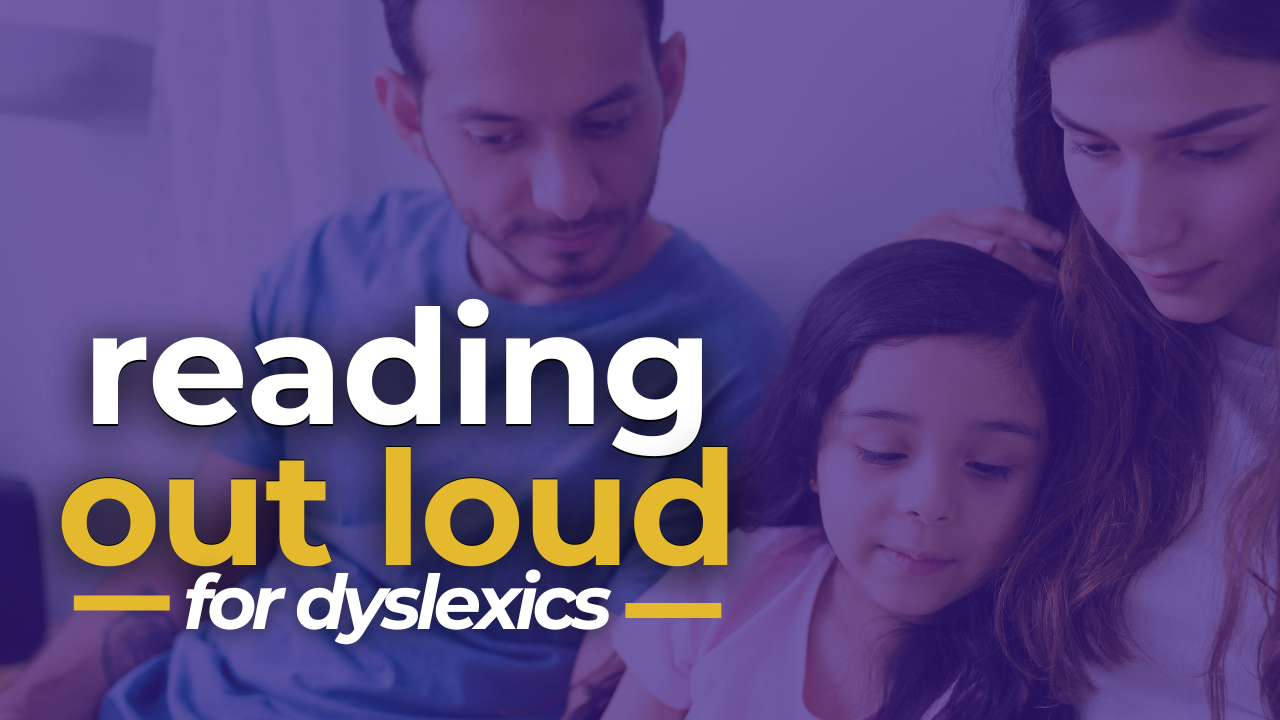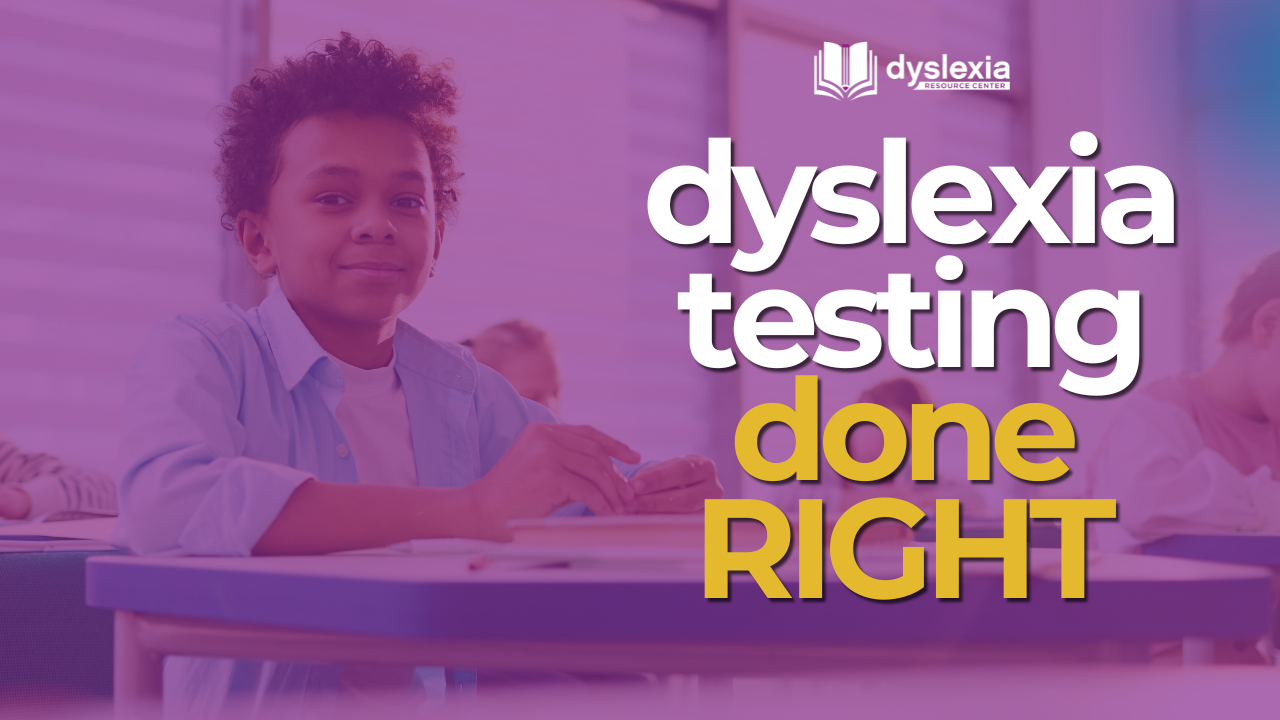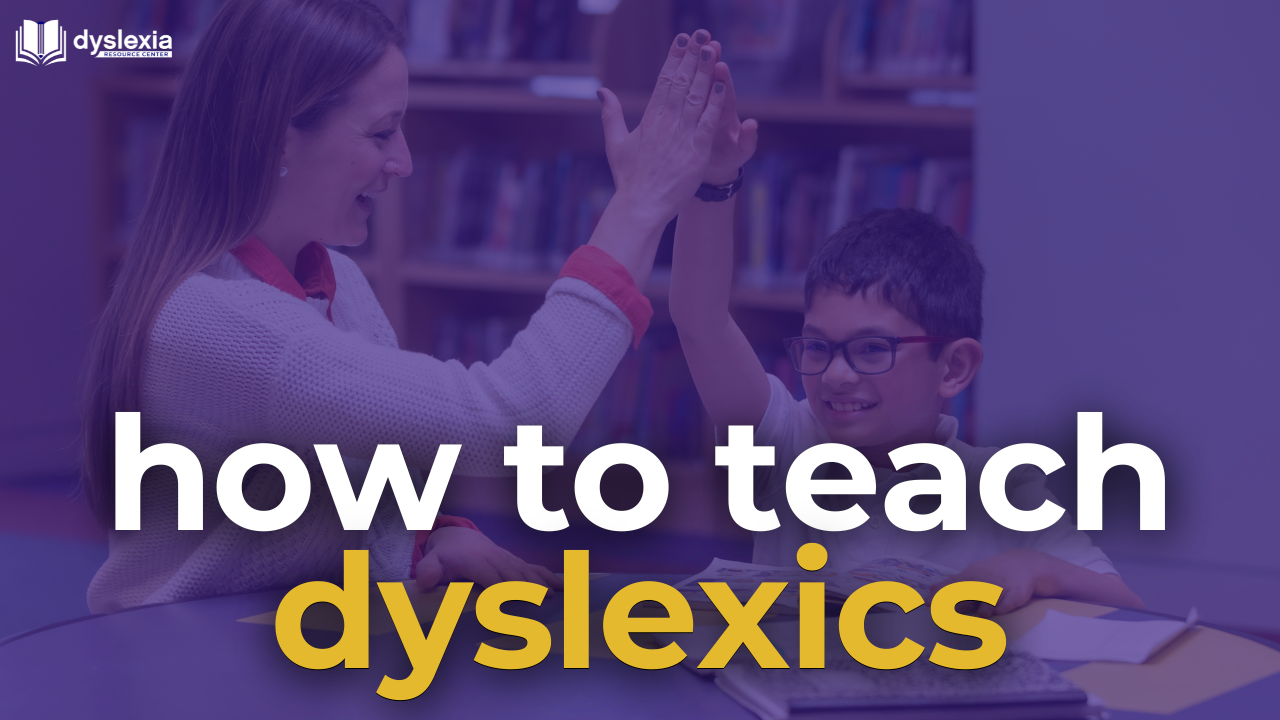Dyslexia in Incarcerated Men and Women: A New Perspective on Reading Disability in the Prison Population
The Journal of Correctional Education 72(2) • September 2021

Laura Cassidy, Kayla Reggio, Bennett A. Shaywitz, John M. Holahan & Sally E. Shaywitz
Abstract
The authors report findings on reading and IQ from a contemporary study of 145 individually tested incarcerated men and women in two maximum-security prisons in Louisiana. To their knowledge this study is the first to use the definition of dyslexia from the First Step Act (FSA) and the first to incorporate an IQ measure to differentiate those with dyslexia from individuals with cognitive impairment. The authors’ findings indicate that almost half (47%) of the participants are classified as having dyslexia, 36% proficient, and 17% cognitive impairment. Both dyslexic prisoners and nondyslexic prisoners reported academic and behavioral problems in school that led to decreased years in school and decreased high school graduation rates, with 87% reporting dropping out of school with many inmates dropping out in middle school (mean age of completion of 9.6 years of school), 97% reporting having been in special education or received accommodations, and 59% having failed to receive a high school diploma or equivalency. The authors note that although the FSA calls for the Bureau of Prisons to screen prisoners for dyslexia using a screener that is evidence- based, with proven psychometrics for validity, efficiency and low cost, as well as readily available, a screener is not a diagnostic instrument and we discuss the next steps after inmates are screened as being dyslexic.
Good evidence from a number of lines of investigation has documented widespread poor reading in prison populations. The percentage of this incarcerated population identified as dyslexic is far higher than the prevalence rate of 20% reported in the general U.S. population from an epidemiological sample survey (detailed in the following), but public policy has not yet acted and delivered solutions. This high prevalence of poor reading in incarcerated individuals has been ascribed to reduced language in family life, poor teaching, cognitive issues, poverty, and learning disabilities. Dyslexia is common in conditions of wealth or poverty, good teaching or bad, and in homes across America. We know that between 80% and 90% of those labeled as having learning disabilities are, in fact, dyslexic. Far too frequently dyslexics are not identified in schools and therefore do not receive effective reading interventions during school, so despite average or even above-average intelligence, they never develop the reading proficiency needed to obtain a job and look to a positive future.
Here we report findings on reading and IQ from a contemporary study of individually tested incarcerated men and women in two maximum-security prisons in Louisiana. These contemporary findings incorporate the provisions of the new 21st-century federal definition of dyslexia in the First Step Act (FSA, 2018).
In this article, we first review selected previous studies of reading in the prison population, studies which have encompassed both in-person evaluations and large-scale examinations of data provided by the prison administration. We next outline dyslexia in the FSA, particularly the first federal definition of dyslexia. We then briefly review the evidence for the definition, epidemiology, and treatment of dyslexia before describing the current study. The methodology, results, and discussion of the current study follow. We discuss how our findings relate to previous studies and conclude with what we consider the next steps after dyslexia is identified in incarcerated individuals.
Selected Previous Studies of Dyslexia in the Prison Population
Previous studies of reading in incarcerated individuals have utilized three distinct kinds of measures using very different sorts of metrics. One group of previous studies has tested prisoners using in-depth measures of reading. Two decades ago, Moody et al. (2000) tested 253 recently incarcerated prisoners, equally divided between men and women and approximately one third African American, one third Hispanic, and one third White. Participants were tested using the Woodcock Reading Mastery Test focusing on word attack and word identification of single-word reading and reading comprehension (Woodcock, 1987). Scoring below the 25th percentile (below a standard score of 90) was considered evidence of dyslexia. Forty-eight percent of inmates scored below the 25th percentile on the word attack test, and 62% percent scored below the 25th percentile on the passage comprehension subtest.
A decade later Shippen et al. (2010) reported Woodcock Reading Mastery scores on word identification, word attack, and passage comprehension on 266 male prisoners in a medium-security prison in Alabama, consisting of 63% African American and 35% European American. They reported that reading standard scores in African American participants were below average (in the 70s) and, for the European American cohort, low average and average (in the 80s and 90s) for word identification and passage comprehension.
A second group of studies on reading by prisoners uses tests developed for examining literacy at national and international levels. These studies examine large samples of adult prisoners using tests that measure prose literacy, document literacy, and quantitative literacy. This metric, although not easily equated to traditional measures of in-depth evaluations of prisoners using tests such as the Woodcock Reading Mastery Test, find that more than two thirds of African American prisoners are reading in the basic or below-basic reading levels in prose literacy and document literacy (Greenberg et al., 2007). This result is consonant with an earlier study using the same metrics of prose literacy and document literacy (Kirsch et al., 1993).
Still another group of studies uses a metric designed for the Program for the International Assessment of Adult Competencies: 2014 (PIAAC; Rampey et al., 2016). In order to be as efficient as possible with participants’ time, each respondent received only a portion of the assessment items. The PIAAC is not designed to provide individual scores, but rather to measure how groups of adults perform on the target domains. The primary goal of the PIAAC’s literacy assessment is to measure everyday literacy, which is defined by the PIAAC framework as “understanding, evaluating, using and engaging with written text to participate in society, to achieve one’s goals and to develop one’s knowledge and potential” (Organisation for Economic Co-operation and Development, 2012) in U.S. households and in the prison population. PIAAC provides information about five levels of literacy skills of adults. Literacy Level 2 includes working with digital or printed texts with tasks requiring matching information and texts, paraphrasing, or use of low-level inferences. Other tasks at Level 2 require comparison and contrast, reasoning, integrations of two or more pieces of information, and navigation of digital texts to identify information in various locations in the document. Approximately half (52%) of household participants scored at or below achievement Level 2, whereas nearly three quarters (72%) of the prison population scored at or below Level 2.
Dyslexia and the First Step Act
Among the provisions in the FSA 2018 (Congressional Research Service, 2019) is the requirement for the Bureau of Prisons to take steps to screen prisoners for dyslexia and to provide programs to treat prisoners who have it. Furthermore, the FSA calls for programs for dyslexia to be incorporated into evidence-based recidivism reduction programs. Critical to this goal, the act defines dyslexia:
The term “dyslexia” means an unexpected difficulty in reading for an individual who has the intelligence to be a much better reader, most commonly caused by a difficulty in the phonological processing (the appreciation of the individual sounds of spoken language), which affects the ability of an individual to speak, read, and spell.
For the first time, it establishes at a federal level that a dyslexic individual can be of average intelligence and even very bright yet read slowly—they don’t have to score below a certain level of reading to be diagnosed.
This is an extremely important law. Of particular importance are provisions in the FSA to ensure reporting of critical components in order for the Attorney General to review how well the law is being implemented in prisons operated by the Bureau of Prisons throughout the United States. These findings are to be sent in a report to the Committee of the Judiciary of the Senate. Data include statistics on the prevalence of dyslexia, effectiveness of screening programs for dyslexia and success (or lack thereof) of any programs implemented to mitigate the effects of dyslexia.
Brief Overview of Dyslexia
Dyslexia was first described over a century ago as an unexpected difficulty in reading by W. Pringle Morgan (1896), a British physician, who reported the case of 14-year-old Percy F., “a bright and intelligent boy, quick at games, and in no way inferior to others of his age. His great difficulty has been—and is now—his inability to learn to read” (p. 1378). Since that original description, the clinical picture of dyslexia as an unexpected difficulty in reading continues to be observed in the thousands of boys and girls and men and women we continue to see today and now validated in scientific studies (Figure 1; Ferrer et al., 2010).
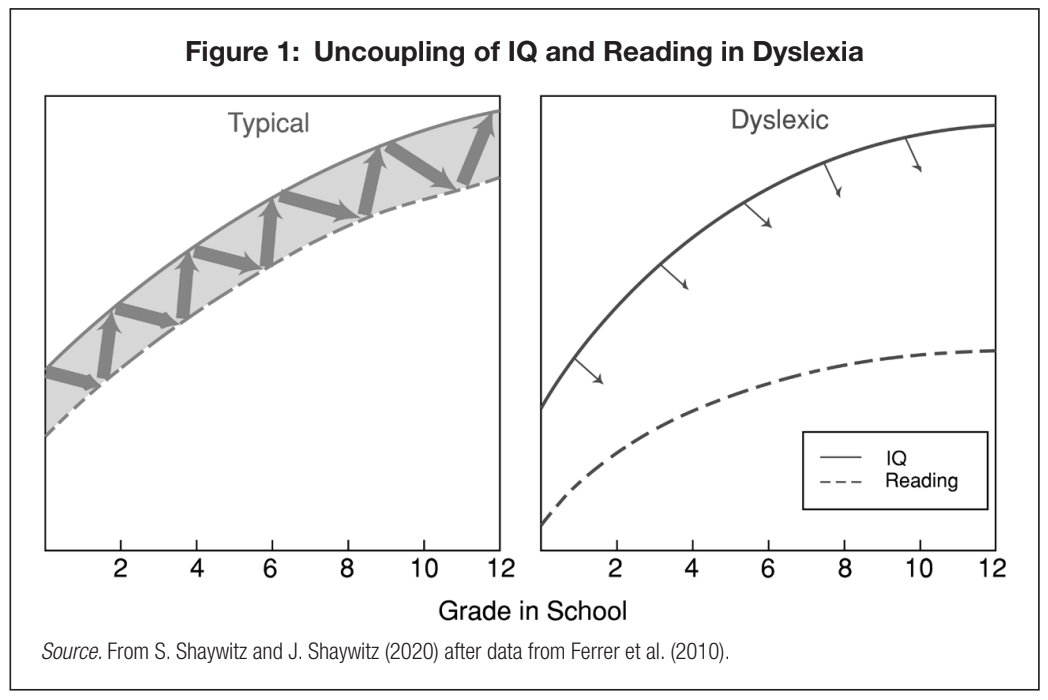
In typical readers (Figure 1, left panel) IQ and reading are dynamically linked over time. If you are intelligent, you are highly likely to be a good reader and conversely, if you are a good reader, you are likely to be intelligent. In contrast, in dyslexic readers (Figure 1, right panel) IQ and reading diverge. In dyslexia a person can have a very high IQ yet read at a much lower level—in dyslexia, poor reading is unexpected. Dyslexics can have a very high level of intelligence yet struggle to read. What is critical is how the dyslexic person goes about reading, for example, the manner in which he or she reads and how long it takes the person to read.
Epidemiology
Dyslexia is universal, affecting all racial, ethnic, and socioeconomic groups (Rudd et al., 2007). Much of what we have come to understand about the epidemiology of dyslexia has emerged from the findings of the Connecticut Longitudinal Study (CLS). Briefly, this study, described in detail on pages 25 to 35 of S. Shaywitz and J. Shaywitz (2020), is a longitudinal epidemiologic sample survey of 445 children entering public kindergarten in Connecticut who have been followed, uninterrupted, since its onset in 1983. We are still following more than 80% of the original population and are currently testing reading (virtually) in this population who are now in their early 40s.
Using data from the CLS, we have been able to demonstrate that dyslexia affects both boys and girls approximately equally, refuting the long-standing dogma that dyslexia is a problem observed only in boys (S. Shaywitz et al., 1990). Our studies, in which every student was individually assessed for dyslexia, have also demonstrated that dyslexia is extremely common, affecting 20% of the population—one in five children, or 10 million American children, have dyslexia (Ferrer et al., 2010, 2015). This means every class has children who are dyslexic. Again, these studies were critical in refuting the extremely low prevalence rates of 0% to 3% to 4% derived from school data, data reflecting the failure of schools to screen for and assess to identify dyslexia. That schools are not identifying dyslexia represents a significant failure in our educational system and obviously reflects on estimates of prevalence, since to be counted as dyslexic children must first be identified—if children are not identified as dyslexic, they obviously cannot be counted.
Neurobiological Progress in Dyslexia
Functional brain imaging (first positron emission tomography [PET] and then functional magnetic resonance imaging [fMRI]) for the first time has made dyslexia, always considered a hidden disability, visible. Figure 2 illustrates what has come to be known as the neural signature for dyslexia—significantly greater activation in posterior reading systems in typical readers than in readers with dyslexia during a task tapping phonologic analysis.
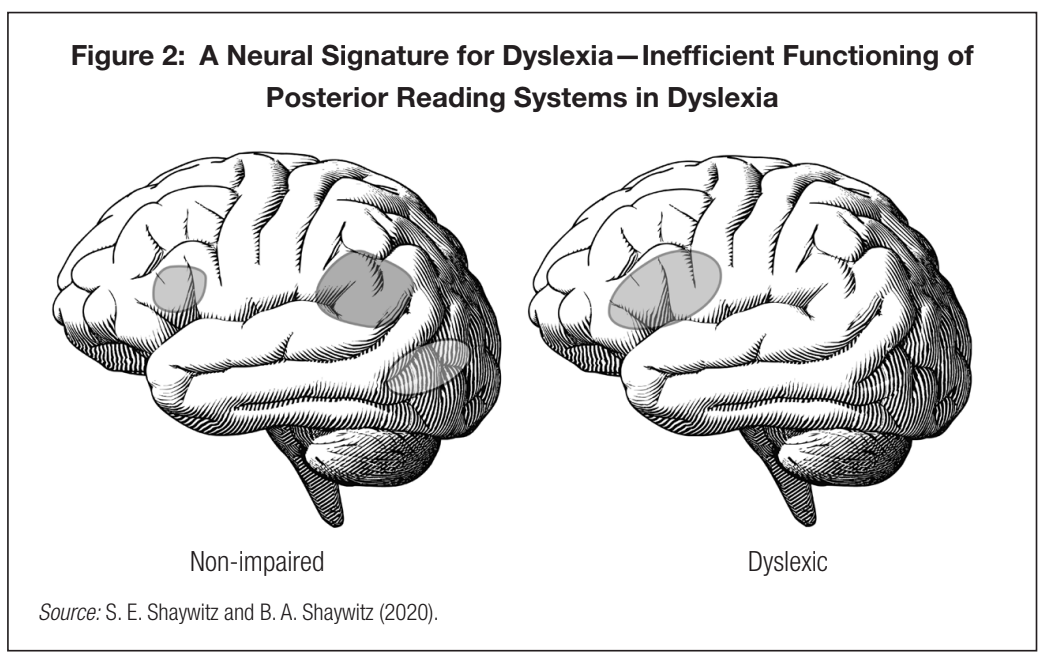
These findings from a study (B. Shaywitz et al., 2002) of 144 children, approximately half of whom had dyslexia and half of whom were typical readers, have been replicated in reports from many investigators worldwide
(Richlan et al., 2009, 2011) and show an inefficient functioning of those left- hemisphere posterior brain systems in children and adults with dyslexia. Good evidence (Price & Devlin, 2011) indicates that a portion of the posterior brain system, the left hemisphere occipitotemporal region, acts as an interactive node for reading, assimilating the orthography (the way the word looks), the phonology (the way the word sounds), and the semantics (what the word means). Details and a more in-depth discussion of functional brain imaging are found in S. Shaywitz and J. Shaywitz (2020, pp. 68–86).
The current study
Methods
Here we describe the cognitive and reading skills and educational attainment of inmates from two maximum-security prisons in Louisiana.
Participants. The target sample for this study was 100 males and 100 females selected at random by the prison education departments at Elayn Hunt Correctional Center and Louisiana Correctional Institute for Women. Elayn Hunt is a maximum-security prison in St. Gabriel, Louisiana. Louisiana Correctional Institute for Women is a maximum-security prison, whose primary location, adjacent to Elayn Hunt, was damaged by flooding in 2016. Women in this maximum-security prison are currently housed in two locations, Elayn Hunt
Correctional Facility in St. Gabriel, Louisiana, and a facility in Baker, Louisiana. A memorandum of understanding was signed with the prison and outlined our proposal to test and then offer recommendations for dyslexic prisoners in continuing education. The cognitive and reading-related measures were administered to those who had signed the consent and completed the background survey.
Because of security and inmate availability limitations, the sample was limited to those inmates with access to the education building in the facility. Availability for visits and routine security procedures limited the participation of some inmates. The first visit included the administration of the consent and background = survey. Up to three sessions were needed to obtain the cognitive and reading-related measures. Here we report data for 145 inmates who completed the background survey and cognitive and reading-related measures.
Measures.
Background survey. The background survey designed by the Dyslexia Resource Center included demographic data and questions about the inmate’s previous educational experience. Questions included highest grade, diploma, or degree completed, and expulsion details, failure or repetition of a grade, difficulty learning to read, and time spent in special education or with accommodations.
Cognitive and reading-related measures. The Kaufman Brief Intelligence Test (KBIT-2; Kaufman & Kaufman, 2004) measures verbal and nonverbal intelligence and is frequently used to quickly assess the intellectual ability of adults in institutional settings, such as prisons, group homes, rehabilitation clinics, or mental health centers. The Comprehensive Test of Phonological Processing, 2nd edition (CTOPP-2; Wagner et al., 2013) measures the ability to blend and isolate parts of words. Phonological Awareness (PA) is the composite of age standard scores for three subtests—Elision, Blending Words, and Phoneme Isolation— and represents the examinee’s awareness of and access to the phonological structure of oral language.
The Test of Word Reading Efficiency (TOWRE-2; Torgesen et al., 2013) measures an individual’s ability to read and pronounce individually presented printed words (Sight Word Efficiency [SWE]) and phonemically regular nonwords (Phonemic Decoding Efficiency [PDE]) accurately and fluently. Because it can be administered very quickly, the test provides an efficient means of monitoring the growth of two kinds of word reading skills that are critical in the development of overall reading ability. The SWE subtest assesses the number of real words
printed in vertical lists that an individual can accurately read aloud in 45 s. Similarly, the PDE subtest measures the number of pronounceable nonwords presented in vertical lists that an individual can read aloud in 45 s. For reading fluency of connected text, we used the Aims Web Oral Reading Fluency test (ORF; Shinn & Shinn, 2002). Participants read aloud two passages. For each passage, the evaluator counts the number of words the participant reads correctly in 1 min.
Procedures and Analysis.
Best estimate classification. Best estimate classification was accomplished using methods established by Leckman et al. ( 1982). Of 165 inmates who participated in the first visit, 155 inmates completed at least some of the cognitive and reading-related measures, with 152 having data sufficient to yield a best estimate classification of their overall reading status. To categorize participants, the following general guidelines were used: a participant was classified as cognitive impairment if their KBIT-2 IQ was below 70, as proficient if their KBIT-2 IQ score was 70 or above and their TOWRE-2 and/or ORF was in a normal range, and as dyslexic if their KBIT-2 IQ was 70 or above and their TOWRE-2 and/or ORF was low. With these as general guidelines, four of the authors (LC, KR, BAS, SES), all of whom have extensive experience evaluating and diagnosing dyslexia, reviewed the history including school history and cognitive and reading-related measures for each inmate, and by consensus developed three classifications of the participants, overall reading status: (1) proficient, (2) dyslexia, or (3) cognitive impairment. A fourth classification,“indeterminate,” was assigned to seven participants for whom no consensus classification could be reached, and these participants were excluded from the final analysis. Data for 145 inmates with a best estimate classification and complete data for the cognitive and reading measures were analyzed and are reported here.
Analysis. Categorical variables were tabulated, and statistical significance was assessed using chi-square tests. Continuous measures were assessed in terms of their means and standard deviations. Linear discriminant analysis (LDA) was used to determine which variables from among age standard scores for K-BIT-2 Composite IQ, CTOPP PA Composite, TOWRE Total (timed word and nonword reading), and the Aims Web ORF raw scores were most highly associated with the classification of inmates as proficient, dyslexic, and cognitively impaired.
Results
Background Survey and Best Estimate Classifications
Summary demographics and educational experiences and best estimate classifications for the sample are presented in Table 1.
The sample was 51% male, 63% African American, with a mean age of 41 years and range of 21 to 75 years, completion of 9.6 years of grade school, and 97% having received 1 or 2 years of special education or accommodations in school. Significantly fewer participants (41%, p = .03) had achieved a high school equivalency certificate or diploma. A majority of 54% of participants self- reported that they had been expelled from school, with significant majorities of 61% and 84% who had failed or repeated a grade and dropped out of school, respectively. A constant theme in the surveys was “difficulty with reading and spelling.” Almost half (47%) of participants were classified as having dyslexia, 36% were proficient readers, and 17% were classified as in the cognitive impairment group.
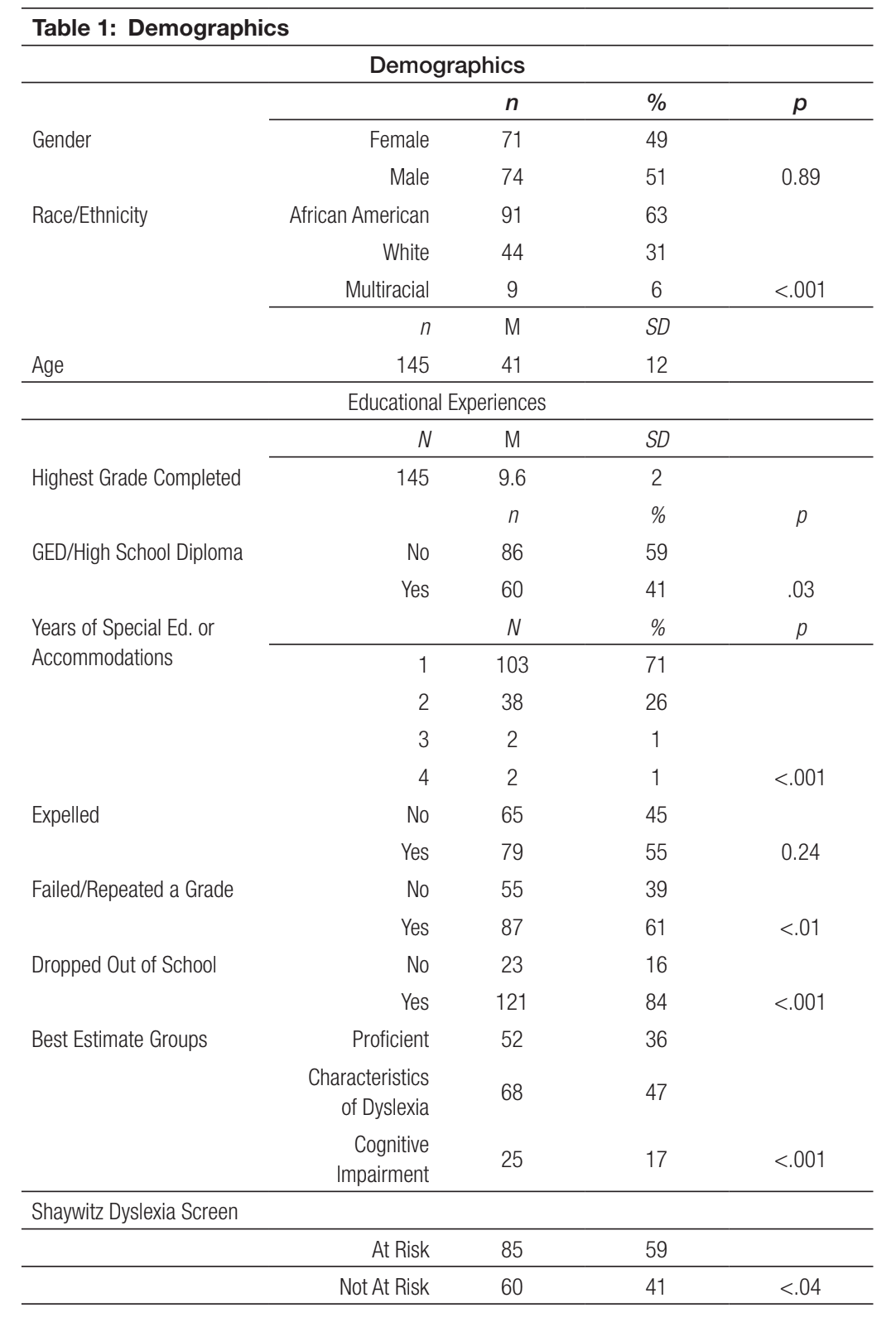
Cognitive and Reading-Related Measures Discriminant Analysis
Means and standard deviations for age and the cognitive and reading-related measures for the three groups are presented in Table 2 and plotted in Figure 3.
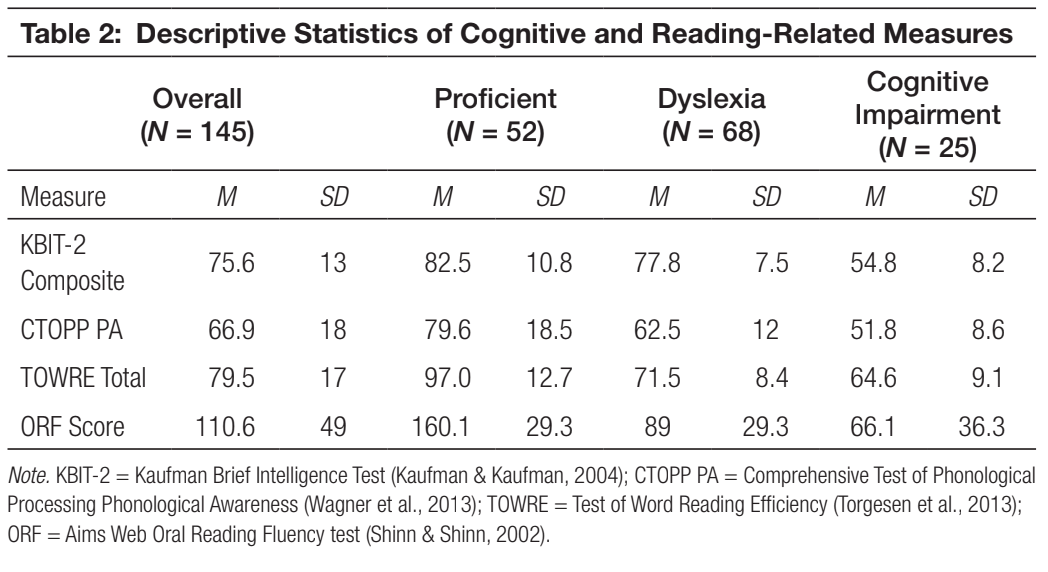
As would be expected, means are consistently highest for the proficient group and lowest for the cognitive impairment group with the means for the dyslexia group intermediate. Note that the cognitive impairment group is separated substantially from the proficient and dyslexia groups on IQ, whereas the proficient group is increasingly separated from the dyslexia and cognitive impairment groups on phonology (CTOPP PA) and fluency (TOWRE Total standard scores and AimsWeb ORF), respectively. The pattern of dispersion suggests that the K-BIT-2 Composite IQ, TOWRE standard scores, and the ORF score are most likely to differentiate the groups in the discriminant analysis.
The discriminant analysis yielded two statistically significant discriminant functions, Wilks’s lambda [4,2,142] = 0.18, approximate F[8,278] = 46.54, p < .001. The discriminant analysis summary statistics are presented in Table 3. The first discriminant function (Factor 1) was moderately associated with IQ (K-BIT-2 Composite IQ) and fluency for connected text (ORF) with standardized loadings of .40 and .50, respectively, with the composite of IQ and fluency for connected text differentiating the groups. In contrast, Factor 2 was very highly associated with IQ (K-BIT-2 Composite IQ standardized loading = .97) and moderately negatively associated with fluency for reading isolated words (TOWRE Total, standardized loading = –.63). Thus, the combination of higher-than-expected IQ and lower-than-expected reading fluency separate the dyslexia group from

the proficient group in Factor 2. The group classifications in Table 3 defined the dispersion pattern in Figure 4.
Jackknifed classifications (for 144 leave-one-out models) in Table 4 indicated that the two discriminant functions correctly classified 89% of cases into the three groups, including 87% of the proficient group, 93% of the dyslexia group, and 84% of the cognitively impaired group.
Discussion
To our knowledge, this study is the first to use the definition of dyslexia from the FSA (2018) to examine dyslexia in incarcerated men and women, defining
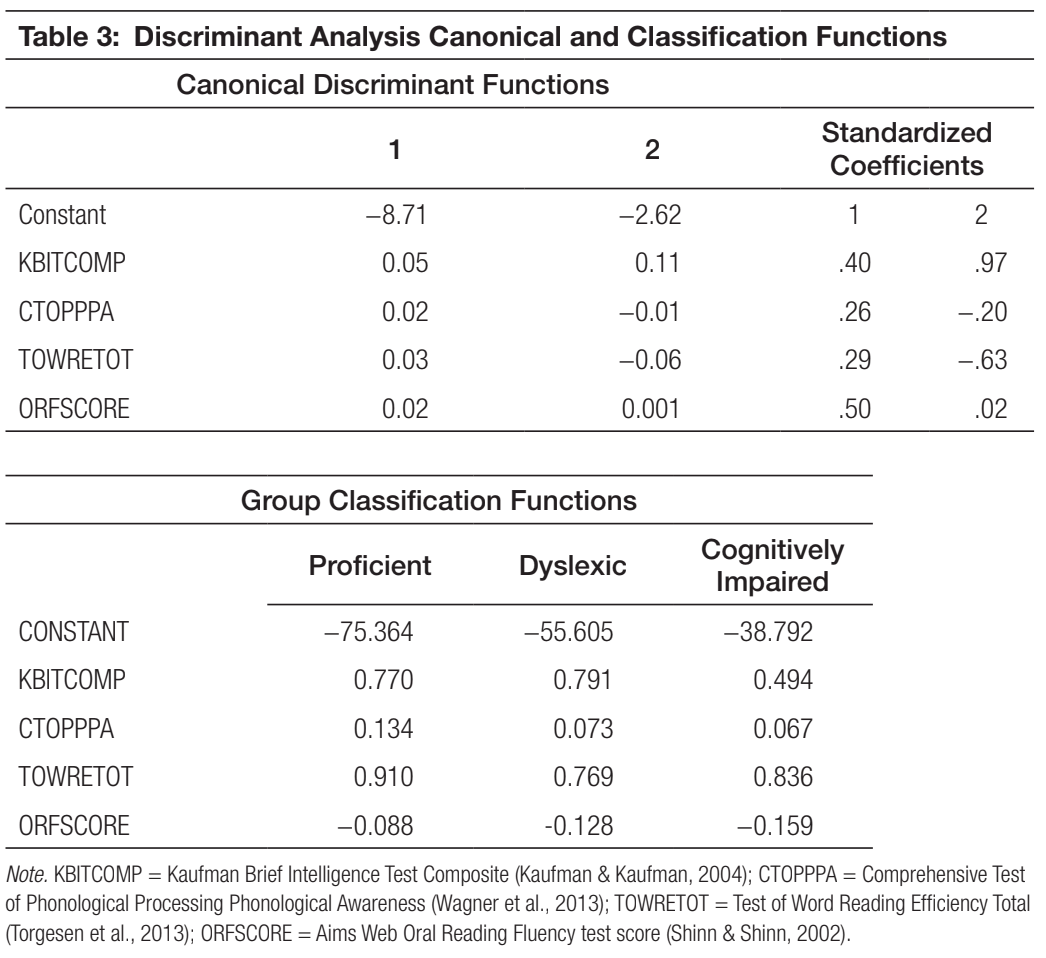
dyslexia as “an unexpected difficulty in reading for an individual who has the intelligence to be a much better reader, most commonly caused by a difficulty in phonological processing.” It is also the first to incorporate an IQ measure (Kaufman & Kaufman, 2004) to differentiate those with dyslexia from individuals with cognitive impairment.
Our findings indicate that almost half (47%) of our participants are classified as having dyslexia, 36% as proficient, and 17% as cognitive impairment. These results are most comparable to findings in a previous study using in-depth measures of reading that found 48% to 62% of the cohort was dyslexic (Moody et al., 2000). It is difficult to directly compare our findings to the only other previous study of in-depth reading because although Shippen et al. (2010) reported Woodcock Reading Mastery standard scores in the 70s for word identification and passage comprehension for African American participants and in the 80s and 90s for the European American cohort, they did not specifically define dyslexia and therefore did not examine the percentage of their sample scoring in the
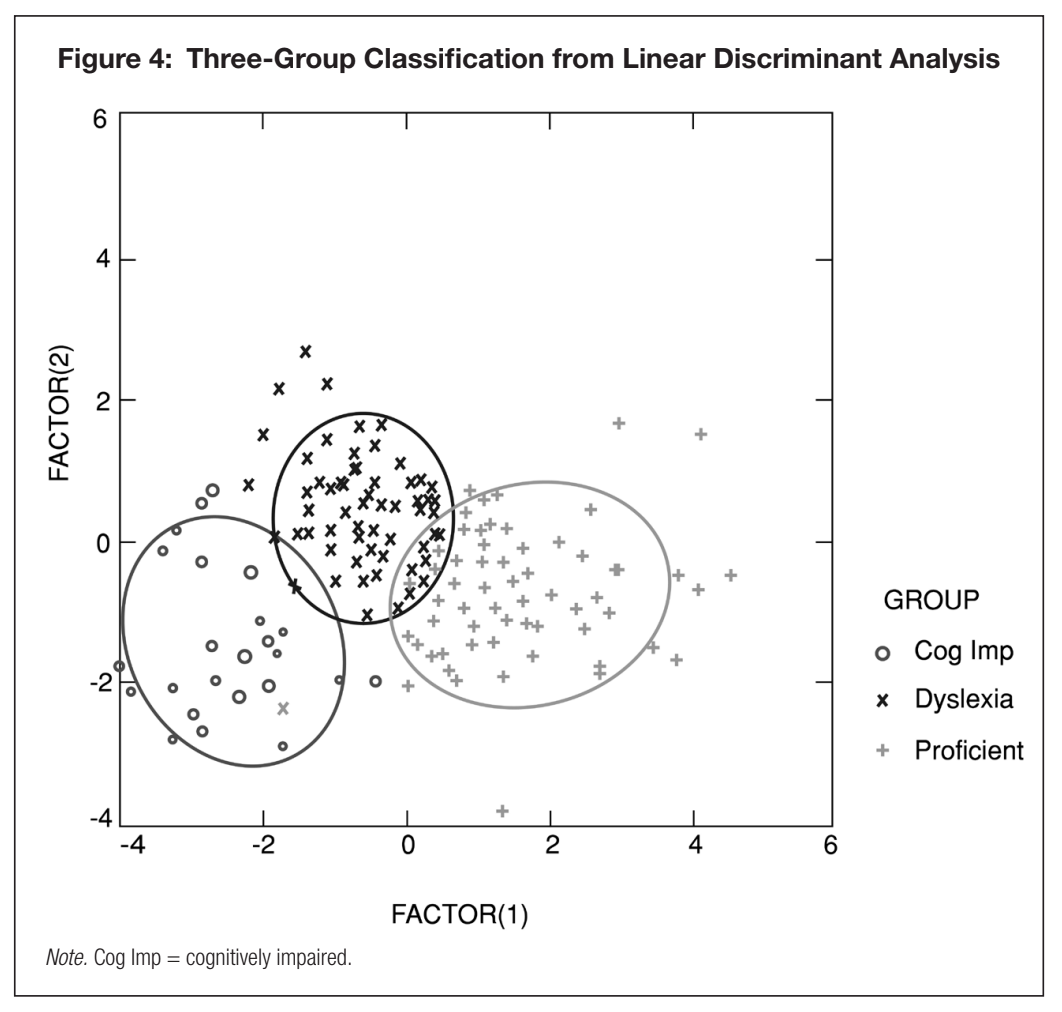
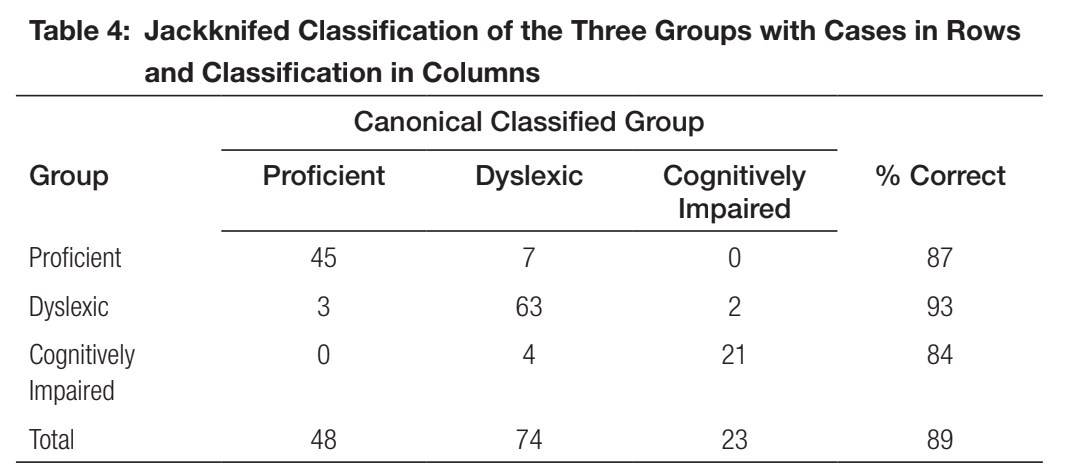
dyslexic range. Those previous studies using tests that measure prose literacy, document literacy, and quantitative literacy, although not directly comparable to the metrics used in our study, find that more than two thirds of African American prisoners are reading in the basic or below-basic reading levels in prose literacy and document literacy (Greenberg et al., 2007; Kirsch et al., 1993). Our findings can also be compared to that group of studies using a metric designed for the Program for the International Assessment of Adult Competencies: 2014 (PIAAC; Rampey et al., 2016). Although the PIAAC is not designed to provide individual scores, PIAAC Literacy Level 2, which requires comparison and contrast, reasoning, integrations of two or more pieces of information, and navigation of digital texts to identify information in various locations in the document, is a reasonable proxy for a cut point for dyslexia. In such studies, prison populations exhibit significantly lower levels of literacy with nearly three quarters (72%) of the prison population achieving at or below Level 2 compared to nonprison populations where approximately half (52%) of household participants achieved at or below achievement Level 2. In sum, our findings demonstrate and confirm the high prevalence of dyslexia in incarcerated individuals, a prevalence considerably greater than the 20% prevalence of dyslexia in the general population. (reviewed in S. Shaywitz & J. Shaywitz, 2020).
Furthermore, both dyslexic prisoners and nondyslexic prisoners reported academic and behavioral problems in school that led to decreased years in school and decreased high school graduation rates, with 87% reporting dropping out of school with many inmates dropping out in middle school (mean age of completion of 9.6 years of school). Nearly all prisoners (97%) reported that they had been in special education or had received accommodations and the majority (59%) failed to receive a high school diploma or equivalency. It is reasonable to suggest that the early school dropout in these dyslexic inmates compounds their slow reading. Furthermore, the testing data confirm that the dyslexic prisoners continue to read slowly and with much effort despite having average intelligence. Reading slowly, less than 120 words per minute with difficulties in decoding and recognizing words, would make obtaining a high school or college diploma difficult, especially if the instructor has little knowledge of dyslexia and does not know that the person is dyslexic. Without interventions in prison focusing explicitly on their dyslexia, dyslexic inmates are forced to repeat an educational pattern that led to their dropping out of middle and high school.
The discriminant analysis provides empirical support for classifying the participants into proficient, dyslexic, and cognitively impaired. The measures most helpful include timed reading of individual words and pseudowords (TOWRE) and timed reading of connected text (ORF), with IQ contributing substantively to classification on both measures. That the composite IQ for the proficient readers is substantially lower than their corresponding performance on the TOWRE and ORF suggests that low levels of verbal knowledge, in general, and vocabulary knowledge, in particular, are common even among the proficient readers. It may be somewhat surprising that phonological awareness failed to be highly associated with classifying the population. The most likely explanation—all three groups, including the proficient readers, performed poorly on the CTOPP PA composite, scoring below a standard score of 80. In contrast, the proficient readers achieved scores in the average range on the TOWRE Composite (standard score = 97) and at the 50th percentile on the ORF (Score = 160 correct words per minute) whereas the dyslexic and cognitively impaired groups attained
ORF scores equivalent to the fourth and first percentiles, respectively.
Next Steps
We view this study as a first step in identifying and intervening with inmates with dyslexia. In the following, we discuss how these data suggest potential recommendations and interventions that could be used by the prison education departments that could assist their efforts to help the individuals toward increased completion of high school equivalency tests and ultimately reduced recidivism. The FSA was signed into law in December 2018 with one of its important components being the establishment of a risk and needs assessment system at the Bureau of Prisons to assess the recidivism risk of all federal prisoners and to place them accordingly in programs to reduce that risk. Inmates who successfully complete a program may earn time credits that allow them to be placed in prerelease custody (James, 2019). Furthermore, the “Attorney General shall incorporate programs designed to treat dyslexia into the evidence-based recidivism reduction plan,” which the dyslexia recidivism reduction pilot project will address as dyslexic inmates are identified under the guidelines of the FSA. Under the FSA, “the Attorney General shall incorporate programs designed to
treat dyslexia into the evidence-based recidivism reduction programs” (James, 2019, pp. 6–7). Furthermore,
the Attorney General shall consider the prevalence and mitigation of dyslexia in prisons, including by reviewing statistics on the prevalence of dyslexia, and the effectiveness of any programs implemented to mitigate the effects of dyslexia, in Prisons and State-operated prisons throughout the United States. (132 STAT. 5194)
In addition, the FSA directed the Bureau of Prisons to incorporate a screening program that is evidence-based, with proven psychometrics for validity, efficient, and low cost, as well as readily available. Evidence-based means the screener is supported by scientific evidence that it is effective. Validity is measured in terms of sensitivity, specificity, and the area under the receiver operating characteristics curve (AUC-ROC). A screener is not a diagnostic instrument—its role is to quickly and efficiently identify those at risk for dyslexia. An example of a screener that meets the FSA criteria is one developed by us and Pearson, the Shaywitz Dyslexia Screen Corrections Form, which is now available and is integrated with the GED Testing Service (S. Shaywitz, 2021). It is appropriate for inmates between the ages of 18 and 65 and consists of 10 items. Psychometrics of the screener are excellent with sensitivity (true positives) .96, specificity .83 (true negatives). AUC-ROC, a metric incorporating both sensitivity and specificity, is very high, .95, where the AUC ranges from .5 (chance accuracy) to 1.0 (perfect accuracy), with 0.7 to 0.9 reflecting a strong clinical assessment. Now that a valid screener is commercially available, inmates can be easily screened and those at risk tested to confirm dyslexia as outlined in this study.
Once screened as at risk for dyslexia those inmates can be evaluated more extensively with, for example, those measures used in this study, encompassing cognitive and reading-related measures. Those inmates identified as dyslexic by the prison education departments should be provided with evidence-based instruction in reading and be encouraged to complete a high school or college degree. The presumption is that with screening, identification, and intervention, there should be a reduction in recidivism—incarcerated individuals can now conceive of a more positive future.
As shown by our findings, the challenges in decoding and reading fluency faced by dyslexic readers have implications for intervention. Educators tasked with providing reading interventions to this inmate population will find that the development of efficient word reading will be a slow and laborious process for readers with dyslexia.
Conclusion
The FSA includes a 21st-century definition of dyslexia and should be used as the foundation for dyslexia screening, testing, and educational instruction in prisons across America.
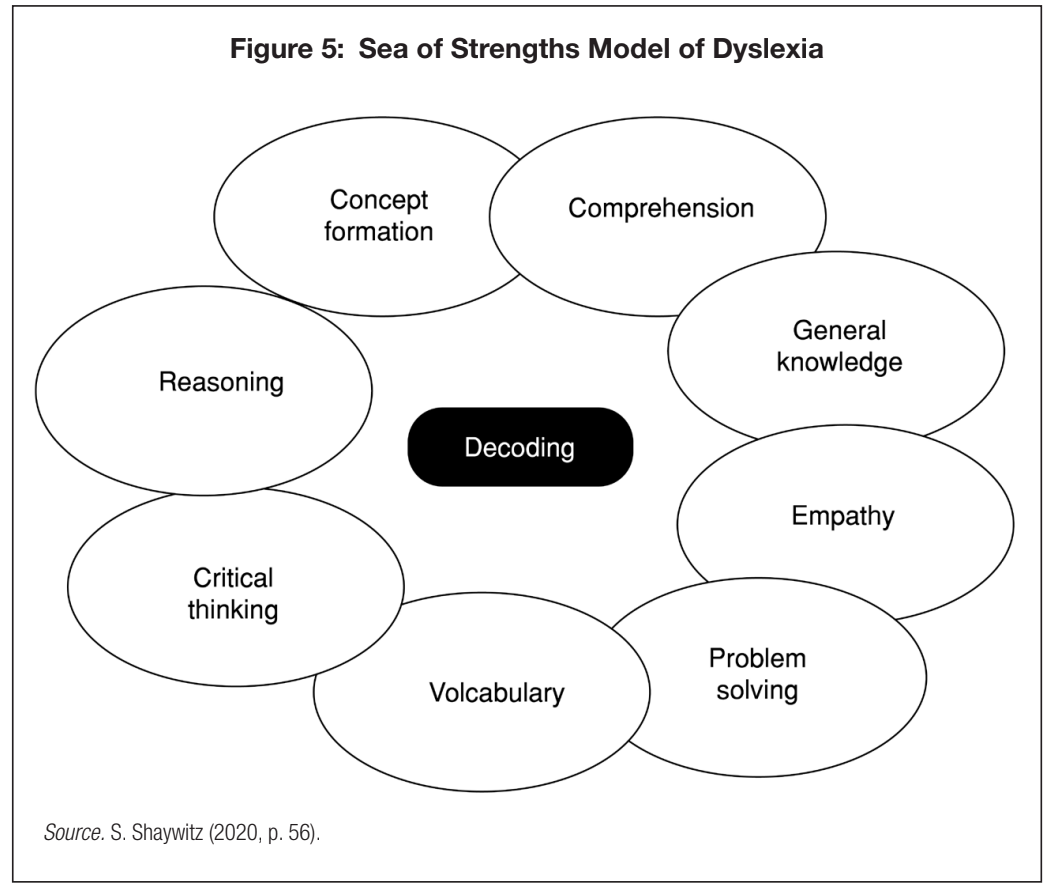
This study utilizing the up-to-date definition and testing confirms a large number, approximately half of those tested, having dyslexia. There is now an evidence-based screener available that is efficient to administer and can be used at intake but appears more appropriate to be used in the education department. Those inmates who are screened and then identified as dyslexic should have the opportunity to further their academic goals with knowledgeable teachers who can help remediate their reading skills and offer accommodations. Identification as dyslexic should improve the inmate’s self-esteem and determination as most struggled in school. Identification gives the teachers insight into the student’s previous academic failures and a pathway
to change academic outcomes and reduce recidivism. Incarcerated individuals diagnosed as dyslexic should be made aware of the Sea of Strengths model of dyslexia (Figure 5)—although they have trouble reading they have strengths in thinking—for example, problem-solving, critical thinking, reasoning. These higher level strengths are often not apparent in the early years of schooling when the focus is on reading the words on the page, which is something unidentified boys and girls with dyslexia struggle to do and are often made fun of and told that they are not very smart. Knowing that they are dyslexic and that dyslexics have a sea of strengths in higher level thinking along with receiving reading help and knowing that many dyslexics who struggled early on go on to lead very rewarding lives in multiple disciplines can bring light and hope into these dyslexic individual’s lives.
References
132 STAT. 5194 PUBLIC LAW 115–391—DEC. 21, 2018 § 3633. Evidence-based recidivism
reduction program and recommendations, 5 (C) b
Congressional Research Service, The First Step Act of 2018: An Overview, March 4, 2019,
https://crsreports.congress.gov R45558
Ferrer, E., Shaywitz, B., Holahan, J., Marchione, K., Michaels, R., & Shaywitz, S. (2015).
Achievement gap in reading is present as early as first grade and persists through
adolescence. Journal of Pediatrics, 167(5), 1121–1125. https://doi.org/10.1016/j
.jpeds.2015.07.045
Ferrer, E., Shaywitz, B., Holahan, J., Marchione, K., & Shaywitz, S. (2010). Uncoupling of
reading and IQ over time: Empirical evidence for a definition of dyslexia. Psychological
Science, 21(1), 93–101. https://doi.org/10.1177/0956797609364084
First Step Act, Pub. L. No. 115-391. (2018). Office of the Federal Register through the
Congressional Printing Management Division, U.S. Government Printing Office.
Greenberg, E., Dunleavy, E., & Kutner, M. (2007). Literacy behind bars: Results from the 2003
National Assessment of Adult Prison Literacy Survey. National Center for Educational Statistics.
James, N. (2019, March 4). The First Step Act of 2018: An overview (R45558). Congressional
Research Services. https://crsreports.congress.gov/product/pdf/R/R45558
Kaufman, A., & Kaufman, N. (2004). (KBIT-2) Kaufman Brief Intelligence Test Second Edition.
Pearson.
Kirsch, I. S., Jungeblut, A., Jenkins, L., & Kolstad, A. (1993). Adult literacy in America: A first look
at the findings of the National Adult Literacy Survey (NCES 93275). National Center for
Educational Statistics.
Leckman, J., Sholomskas, D., Thompson, W., Belanger, A., & Weissman, M. (1982). Best
estimate of lifetime psychiatric diagnosis: A methodological study. Archives of General
Psychiatry, 39(8), 879–883. https://doi.org/10.1001/archpsyc.1982.04290080001001
Moody, K., Holzer, C., Roman, M., Paulsen, K., Freeman, D., Haynes, M., & James, T. (2000).
Prevalence of dyslexia among Texas prison inmates. Texas Medicine, 96(6), 69–75.
Morgan, W. P. (1896, November 7). A case of congenital word blindness. British Medical
Journal, 2, 1378. https://doi.org/10.1136/bmj.2.1871.1378
Organisation for Economic Co-Operation and Development (2012). Literacy, Numeracy, and
Problem Solving in Technology-Rich Environments: Framework for the OECD Survey of Adult
Skills, OECD Publishing. http://www.oecd-ilibrary.org/education/literacy-numeracy
-and-problem-solving -in-technology-rich-environments_9789264128859-en
Price, C., & Devlin, J. (2011). The interactive account of ventral occipitotemporal
contributions to reading. Trends in Cognitive Sciences, 15(6), 246–253. https://doi.org/
j.tics/2011.04.001
Rampey, B., Keiper, S., Mohadjer, L., Krenzke, T., Li, J., Thornton, N., & Hogan, J. (2016).
Highlights from the U.S. PIAAC Survey of Incarcerated Adults: Their skills, work experience,
education, and training: Program for the International Assessment of Adult Competencies:
2014 (NCES 2016-040). National Center for Education Statistics http://nces.ed.gov/
pubsearch
Richlan, F., Kronbichler, M., & Wimmer, H. (2009). Functional abnormalities in the dyslexic
brain: A quantitative meta-analysis of neuroimaging studies. Human Brain Mapping,
30(10), 3299–3308. https://doi.org/10.1002/hbm.20752
Richlan, F., Kronbichler, M., & Wimmer, H. (2011). Meta-analyzing brain dysfunctions in
dyslexic children and adults. NeuroImage, 56(3), 1735–1742. https://doi.org/10.1016/
j.neuroimage.2011.02.040
Rudd, R., Anderson, J., Oppenheimer, S., & Nath, C. (2007). Health literacy: An update of
medical and public health literature In J. Comings, B. Garner, & C. Smith (Eds.), Review of
adult learning and literacy: Connecting research, policy, and practice (Vol. 7, pp. 175–203).
Erlbaum.
Shaywitz, B. A., Shaywitz, S. E., Pugh, K. R., Mencl, W. E., Fulbright, R. K., Skudlarski, P.,
Constable, R. T., Marchione, K. E., Fletcher, J. M., Lyon, G. R., & Gore, J. C. (2002).
Disruption of posterior brain systems for reading in children with developmental
dyslexia. Biological Psychiatry, 52(2), 101–110. https://doi.org/10.1016/s0006-3223(02)
01365-3
Shaywitz, S. (2021). Shaywitz DyslexiaScreen Corrections Form manual. NCS Pearson Inc.
Shaywitz, S., Shaywitz, B., Fletcher, J., & Escobar, M. (1990). Prevalence of reading disability
in boys and girls: Results of the Connecticut Longitudinal Study. Journal of the American
Medical Association, 264(8), 998–1002. doi:10.1001/jama.1990.03450080084036
Shaywitz, S., & Shaywitz, J. (2020). Overcoming dyslexia (2nd ed.). Alfred A. Knopf.
Shaywitz, S. E., & Shaywitz, B. A. (2020). Dyslexia. In R. M. Kliegman, B. F. Stanton, J. W. I. St.
Geme, N. F. Schor, & R. E. Behrman (Eds.), Nelson textbook of pediatrics (21st ed., Vol. 1,
pp. 267–269). Saunders Elsevier.
Shinn, M., & Shinn, M. (2002). AIMSweb training workbook: Administration and scoring of
Reading Curriculum-Based Measurement (R-CBM) for use in general outcome measurement.
Edormation, Inc.
Shippen, M. E., Houchins, D. E., Crites, S. A., Derzis, N. C., & Patterson, D. (2010). An
examination of the basic reading skills of incarcerated males. Adult Learning, 21(3–4),
4–12. https://doi.org/10.1177/104515951002100301
Torgesen, J., Wagner, R., & Rashotte, C. (2013). TOWRE-2: Test of Word Reading Efficiency. PRO-ED.
Wagner, R., Torgesen, J., Rashotte, C., & Pearson, N. (2013). CTOPP-2: Comprehensive
Test of Phonological Processing (n. ed Ed.). PRO-ED. https://www.proedinc.com/
Products/13080/ctopp2-comprehensive-test-of-phonological-processingsecond
-edition.aspx
Woodcock, R. W. Woodcock Reading Master’s Test - Revised: Examiner’s Manual. Circle Pines,
Minn: American Guidance Service; 1987.
Biographical Sketches
LAURA CASSIDY, MD, is the founder and board president of both the Dyslexia Resource
Center and Louisiana Key Academy, a public charter school for children with dyslexia.
KAYLA REGGIO, MEd, is the director of the Dyslexia Resource Center and a qualified
instructor and certified academic language therapist who has served students and adults
with dyslexia of all ages through assessment, remediation, and working to certify other
professionals in the dyslexia remediation field.
BENNETT A. SHAYWITZ, MD, is the Charles and Helen Schwab Professor in Dyslexia and
Learning Development at Yale University, the author of more than 350 scientific papers,
and a member of the National Academy of Medicine within the National Academies.
JOHN M. HOLAHAN, PhD, is the director of data management at the Yale Center for
Dyslexia & Creativity at Yale University School of Medicine.
SALLY E. SHAYWITZ, MD, is the Audrey G. Ratner Professor in Learning Development at
Yale University, a member of the National Academy of Medicine, and the author of more
than 350 scientific articles and Overcoming Dyslexia, the go-to book on dyslexia.
